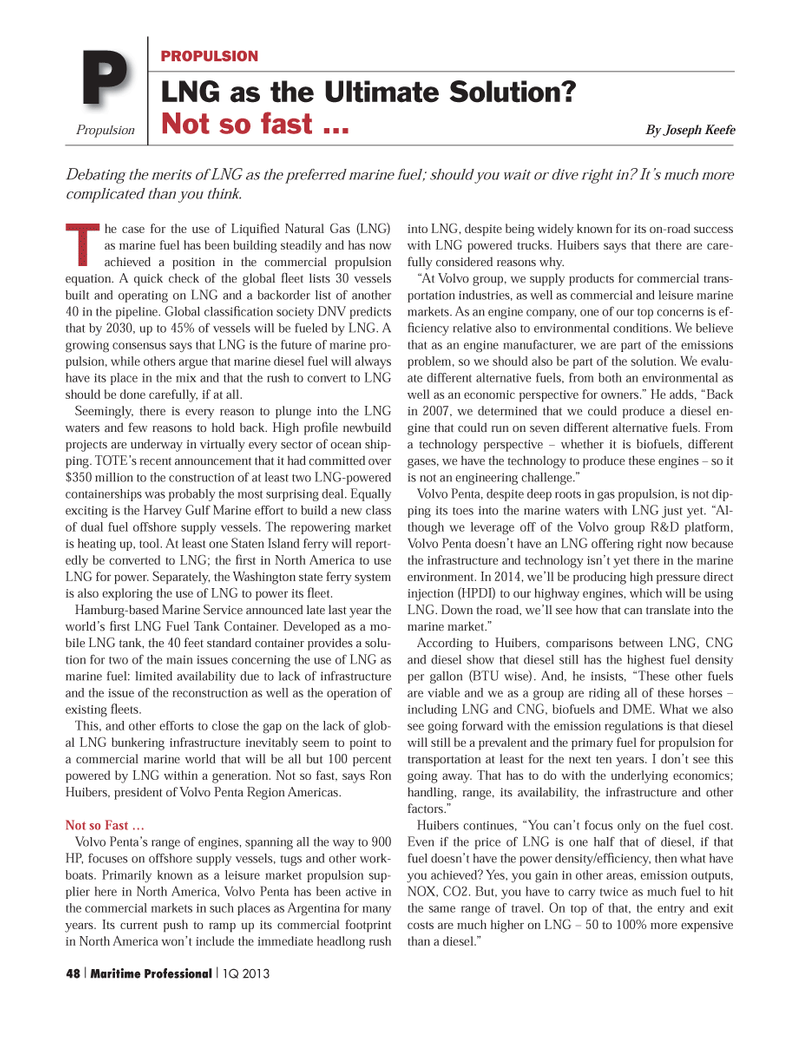
Page 48: of Maritime Logistics Professional Magazine (Q1 2013)
Maritime Risk
Read this page in Pdf, Flash or Html5 edition of Q1 2013 Maritime Logistics Professional Magazine
The case for the use of LiquiÞ ed Natural Gas (LNG) as marine fuel has been building steadily and has now achieved a position in the commercial propulsion equation. A quick check of the global ß eet lists 30 vessels built and operating on LNG and a backorder list of another 40 in the pipeline. Global classiÞ cation society DNV predicts that by 2030, up to 45% of vessels will be fueled by LNG. A growing consensus says that LNG is the future of marine pro- pulsion, while others argue that marine diesel fuel will always have its place in the mix and that the rush to convert to LNG should be done carefully, if at all. Seemingly, there is every reason to plunge into the LNG waters and few reasons to hold back. High proÞ le newbuild projects are underway in virtually every sector of ocean ship- ping. TOTEÕs recent announcement that it had committed over $350 million to the construction of at least two LNG-powered containerships was probably the most surprising deal. Equally exciting is the Harvey Gulf Marine effort to build a new class of dual fuel offshore supply vessels. The repowering market is heating up, tool. At least one Staten Island ferry will report- edly be converted to LNG; the Þ rst in North America to use LNG for power. Separately, the Washington state ferry system is also exploring the use of LNG to power its ß eet. Hamburg-based Marine Service announced late last year the worldÕs Þ rst LNG Fuel Tank Container. Developed as a mo- bile LNG tank, the 40 feet standard container provides a solu- tion for two of the main issues concerning the use of LNG as marine fuel: limited availability due to lack of infrastructure and the issue of the reconstruction as well as the operation of existing ß eets. This, and other efforts to close the gap on the lack of glob- al LNG bunkering infrastructure inevitably seem to point to a commercial marine world that will be all but 100 percent powered by LNG within a generation. Not so fast, says Ron Huibers, president of Volvo Penta Region Americas. Not so Fast ? Volvo PentaÕs range of engines, spanning all the way to 900 HP, focuses on offshore supply vessels, tugs and other work- boats. Primarily known as a leisure market propulsion sup- plier here in North America, Volvo Penta has been active in the commercial markets in such places as Argentina for many years. Its current push to ramp up its commercial footprint in North America wonÕt include the immediate headlong rush into LNG, despite being widely known for its on-road success with LNG powered trucks. Huibers says that there are care- fully considered reasons why. ÒAt Volvo group, we supply products for commercial trans- portation industries, as well as commercial and leisure marine markets. As an engine company, one of our top concerns is ef- Þ ciency relative also to environmental conditions. We believe that as an engine manufacturer, we are part of the emissions problem, so we should also be part of the solution. We evalu- ate different alternative fuels, from both an environmental as well as an economic perspective for owners.Ó He adds, ÒBack in 2007, we determined that we could produce a diesel en-gine that could run on seven different alternative fuels. From a technology perspective Ð whether it is biofuels, different gases, we have the technology to produce these engines Ð so it is not an engineering challenge.Ó Volvo Penta, despite deep roots in gas propulsion, is not dip- ping its toes into the marine waters with LNG just yet. ÒAl- though we leverage off of the Volvo group R&D platform, Volvo Penta doesnÕt have an LNG offering right now because the infrastructure and technology isnÕt yet there in the marine environment. In 2014, weÕll be producing high pressure direct injection (HPDI) to our highway engines, which will be using LNG. Down the road, weÕll see how that can translate into the marine market.Ó According to Huibers, comparisons between LNG, CNG and diesel show that diesel still has the highest fuel density per gallon (BTU wise). And, he insists, ÒThese other fuels are viable and we as a group are riding all of these horses Ð including LNG and CNG, biofuels and DME. What we also see going forward with the emission regulations is that diesel will still be a prevalent and the primary fuel for propulsion for transportation at least for the next ten years. I donÕt see this going away. That has to do with the underlying economics; handling, range, its availability, the infrastructure and other factors.Ó Huibers continues, ÒYou canÕt focus only on the fuel cost. Even if the price of LNG is one half that of diesel, if that fuel doesnÕt have the power density/efÞ ciency, then what have you achieved? Yes, you gain in other areas, emission outputs, NOX, CO2. But, you have to carry twice as much fuel to hit the same range of travel. On top of that, the entry and exit costs are much higher on LNG Ð 50 to 100% more expensive than a diesel.Ó Propulsion PROPULSION LNG as the Ultimate Solution? Not so fast ?PBy Joseph Keefe Debating the merits of LNG as the preferred marine fuel; should you wait or dive right in? It?s much more complicated than you think. 48 I Maritime Professional I 1Q 2013MP #1 34-49.indd 48MP #1 34-49.indd 482/25/2013 10:11:49 AM2/25/2013 10:11:49 AM

 47
47

 49
49
